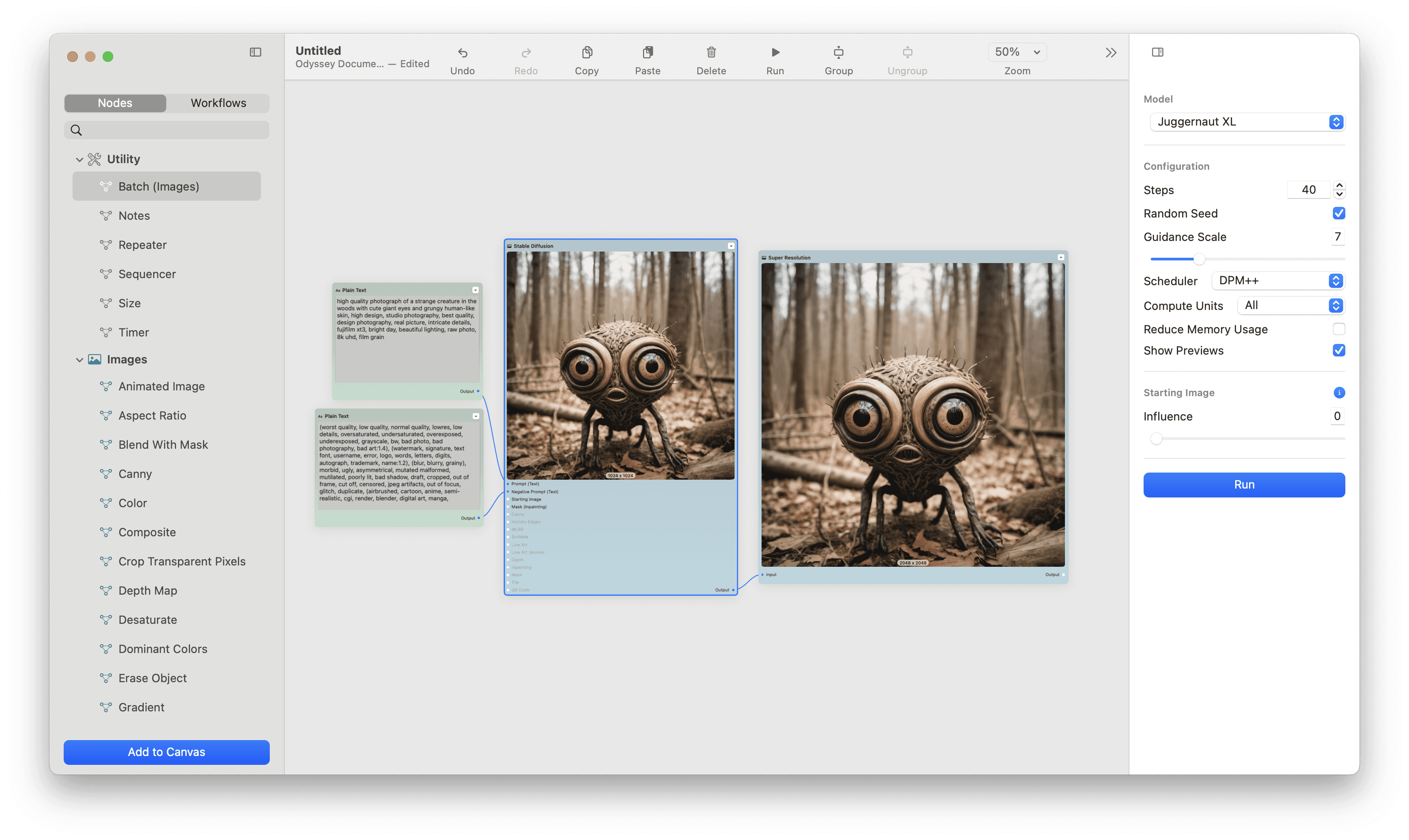
If you google How to Run Stable Diffusion on a Mac you'll find in-depth tutorials that cover setting up Homebrew, installing packages, and running commands in terminal. The reality is that, until recently, running Stable Diffusion locally on a Mac was challenging.
That's no longer the case. Now, with just a few clicks you can get Stable Diffusion up and running on your Mac without any code. We'll look at no code approaches to running Stable Diffusion locally as well as approaches that require some coding as well.
Local Image Generation - No Code
We think Odyssey is probably the easiest way to get started running AI models locally. When you download Odyssey, we also download and set up image generation models to make it extremely simple to get started. There are also 70+ additional nodes so you can create or run powerful AI workflows. Odyssey also supports running LLMs locally - which makes it a one-stop shop for local AI models on your Mac. Odyssey's also a truly native Mac app that follows Apple design paradigms so the user experience is polished and well thought out. Odyssey is also extremely well documented, so it's easy to learn as you begin to master local image generation.
The downside of Odyssey is that it's still in public beta - that means that while some parts of the app are feature complete, there's still active development happening to fix bugs, improve the experience, and add features. We might be biased but once it's complete, we're confident it will be the best on the market.
DrawThings is an excellent app from an indie development team that focus entirely on local image and video generation. DrawThings generation pipeline is extremely impressive (and partly open source!) which makes image generation through their software quite fast.
There are downsides with DrawThings, though. While it's simple to download, the user experience and design of the app isn't very polished - which can make it a bit challenging to use. It's also limited almost entirely to image generation - so while there is support for things like ControlNet, it isn't particularly intuitive.
That being said, if you're looking to just generate images quickly on a Mac, DrawThings is an excellent option.
Mochi Diffusion is a bit more challenging to get up and running than DrawThings or Odyssey, but this entirely open source project has a vibrant and welcoming community around it. Mochi Diffusion uses Apple's CoreML implementation to run Stable Diffusion locally, which means memory requirements are low and image generation is fast.
The downsides for Mochi Diffusion are the limitations of a CoreML focused implementation and the focus solely on image generation - without any of the bells and whistles. But if you're looking for a true open source project, we love Mochi Diffusion and, most of all, the people that contribute to it.
Local Image Generation - Some Code required
ComfyUI is an open source software project that takes a node based approach to image generation. Because of ComfyUI's open source status, it is typically one of the first ways to leverage new AI models. It is also extremely powerful and lets you granularly change individual parts of the model through a complex, node based system.
With power, though, comes complexity. ComfyUI can be very challenging to use. It requires some engineering knowledge to install on a Mac, the UI can be difficult to understand, and there's a steep learning curve to get everything working and running. The software also seems to be better suited for Nvidia processors, which means that image generation times aren't always the fastest.
Automatic1111 and Fooocus are both web based UIs that generate images locally. This means that, like ComfyUI, they show up in a browser window but leverage your computer's memory to generate images. Both are open source software projects and while they're more accessible than ComfyUI, they do require configuration and some coding to get started.
But once you do figure out how to use them, they are straightforward and powerful methods for generating AI imagery.
Comparison
如有侵权请联系:admin#unsafe.sh





